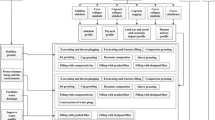Abstract
Karstic erosion of the land surface is controlled by processes occurring in the epikarstic zone—the upper portion of the limestone which is most intensely dissolved. Sinkholes developing today are generally the effects of downward movement of mantling sediment into the major karren shafts which drain the epikarstic zone deeper into the true karstic aquifer. Dissolution of the limestone itself does not cause significant changes in man's time frame. The downward erosion of mantling sediment is termed ravelling. Only in uniform sediment will an arched cavity occur. In unconsolidated sediment which is stratified, lateral tunnelling may even occur. Only the major karren can transmit sediment downward, the majority are ineffective. In mantled karst the location of surficial depressions and photo-linears does not necessarily correlate to areas of new collapse. The irregular and highly dissolved character of the epikarstic zone complicates foundation engineering. Downward drainage through this zone may be limited and cause flooding. An understanding of processes in the epikarstic zone is essential in developing on karst.
Similar content being viewed by others
References Cited
Alexander, C. A., and P. R. Book, 1984, Altura, Minnesota, lagoon collapses.In Beck, B. F., ed., Sinkholes: their geology, engineering, and environmental impact—proceedings of the first multidisciplinary conf. on sinkholes: Rotterdam, A. A. Balkema Publishers, p. 311–318.
Brook, G. A. and T. L. Allison, 1981, Subsidence susceptibility models for Dougherty Country, Georgia, from sinkhole and fracture distribution data.In Beck, B. F., ed., Proceedings of the eighth int. cong. of speleology, v. I., p. 50–52.
Crawford, N. C., 1984, Sinkhole flooding associted with urban development of karst terrain: Bowling Green, Kentucky. (In Beck, B. F., ed., Sinkholes: their geology, engineering, and environmental impact—proceedings of the first multidisciplinary conf. on sinkholes: Rotterdam, A. A. Balkema Publishers, p. 283–292.
Dinger, J. S., and J. R. Rebman, 1986, Ordinance for the control of urban development in sinkhole areas in the Blue Grass Region, Lexington, Kentucky.In Proceedings of the environmental problems in karst terranes and their solutions conference: Dublin, OH, Water Well Journal Pub. Co., p. 163–180.
Foose, R. M., and J. A. Humphreville, 1979, Engineering geological approaches to foundations in the karst terrain of the Hershey Valley: Bul. of the Assoc. of Eng. Geol., v. XVI, no. 3, p. 355–381.
Florida Sinkhole Research Institute, 1986, Cover-subsidence sinkholes damage homes in Tampa: Update (FSRI Newsletter), v. 4, no. 3, p. 1 and 5.
Hutton, J. G., A. C. Hine, M. W. Evans, E. B. Osking, and D. F. Belknap, 1984, Influence of a karstified limestone surface on an open-marine marsh-dominated coastline: West Central Florida.In Beck, B. F., ed., Sinkholes: their geology, engineering, and environmental impact—proceedings of the first multidisciplinary conf. on sinkholes: Rotterdam, A. A. Balkema Publishers, p. 311–318.
Newton, J. G., 1987, Development of sinkholes resulting from man's activities in the Eastern United States: U.S. Geological Survey Circular 968, 54 p.
Nat. Water Well Association, 1986, Proceedings of the environmental problems in kast terrenes and their solutions conference: Dublin, OH, Water Well Journal Pub. Co., 525 p.
Quinlan, J. F., 1984, Litigious problems associated with sinkholes, emphasizing recent Kentucky cases alleging liability when sinkholes were flooeded:In B. F. Beck, ed, Sinkholes: their geology, engineering, and environmental impact—proceedings of the first multidisciplinary conf. on sinkholes: Rotterdam, A. A. Balkema Publishers, p. 293–295.
Rutledge, A. T., 1982, Hydrology of the floridan aquifier in northwest Volusia County, Florida: Dept. of Natural Resources, Bureau of Geology Bull., No. 31, 461 p.
Sowers, G. F., 1975, Failures in limestones in humid subtropics: J. Geotech. Eng. Div. ASCE, p. 771–787.
Williams, P. W., 1985, Subcutaneous hydrology and the development of doline and cockpit karst. Zeitschrift fur Geomorphologie N.F., Bd. 29, Heft 4, p. 463–482.
Wilson, W. L., and K. M. McDonald, 1987, Frequency of sinkhole development in the vicinity of the Southwest Landfill, Alachua County, Florida: Fl. Sinkhole Res. Inst. Rpt. 87-88-2, U. of Cen. Fl., Orlando, 20 p.
Wilson, W. L., K. M. McDonald, B. L. Barfus, and B. F. Beck, 1987, Hydrogeologic factors associated with recent sinkhole development in the Orlando Area, Florida: Fl. Sinkhole Res. Inst. Rpt. 87-88-4, U. of Cen. Fl., Orlando, 104 p.
Author information
Authors and Affiliations
Rights and permissions
About this article
Cite this article
Beck, B.F. Environmental and engineering effects of Sinkholes—the processes behind the problems. Environ. Geol. Water Sci 12, 71–78 (1988). https://doi.org/10.1007/BF02574791
Issue Date:
DOI: https://doi.org/10.1007/BF02574791



